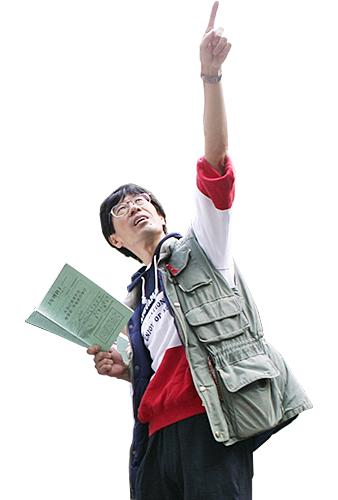理科教諭なべやんの「学内探訪」 Nabeyan's Column
2016年5月より、本校理科教諭の田邉利幸が綴った「学内探訪」コラムを連載していきます。
キャンパス内の名所や豊かな自然環境をご紹介していきます。
連載!理科教諭なべやんの「学内探訪」
<掲載に際して>
「学校」という空間は、人間が生活する環境の中でも”特異”な空間です。本校の場合主に近畿圏各地の居住地域から、900名近い人々がこの岩倉の地に通い、集い、学び、お互いを高め成長する場となっています。
そして午前8時から午後5時までの校内は、未来の無限の可能性を秘めた若者の活気が満ち満ちています。ある場面では授業としての「教科の学び」が、また「かけがえのない友人との語り合いや交流」が、そして放課後は「個性的で多様な先輩や後輩との学び合い」と、学び通しの9時間があっという間に過ぎていきます。
これらのさまざまな経験は、今後の豊かな人生を築き上げていく上で何よりも大切な宝物です。
そんな豊かな3年間を「学校環境」の視点から振り返ってみた時、この地には四季折々に変化する比叡山や北山、西に流れる岩倉川の自然の景観や、季節の移ろいを感じて多様に変遷する豊かな動植物が生息しています。そして同時に、香山建築研究所の設計による建造物、空間構成、そこに組み込まれた”芸術作品”にも注目したいと感じました。子どもたちが快適に生活できることを何よりも大切にし、校地の空間や構造物のデザイン、校舎間や空き地への動きを科学する「動線の科学」、教科教室内の機能性や教科MSの空間構成など、本校に関わるデザイン的要素のすべてが「芸術作品」であり、また、「建築工学の最先端の現場」でもあるように思うのです。いわば子どもたちは、宇宙・自然・芸術・環境・人間・工学の多様な視点から創造された作品群の中で学校生活を送っていると言っても過言ではないと思います。
ある時、何気なく校内を歩いていると、自然物や構造物の方から次から次にメッセ-ジが伝わってきました。今回そのメッセ-ジに促されて、「学内探訪」(適宜「学外探訪」も)と題する連載を記してみます。雑駁な文章で不足を感じる点は多々ありますが、ご一読いただきご批判、ご鞭撻いただければ幸いです。尚、英文Summaryは本校英語科のDavid Foremanが担当しています。
田邉利幸
第73回 秋の実りと香りの深み
~果実の戦略~

季節は着実に「夏」から「秋」へと移りかわり、ナツアカネは姿を消し、校内の樹々は日々、秋の装いに変化してきました。
西側の芝生地では、カリン(バラ科)の果実がたわわに実り、甘くかぐわしい芳香が気持ちをリラックスさせてくれます。
さて、「実り」は次なる世代へのバトンですが、植物の「果実」には、いったいどのような生存戦略が隠されているのでしょうか?
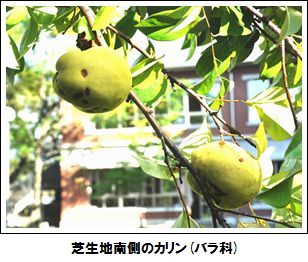
理科野外MSで育っているイチヂクの甘い実は、ヒヨドリやムクドリが目ざとく見つけ、ついばんでくれています。キンモクセイなどの香りには、ハエやハチが訪れ、花粉を媒介してくれています。甘さや独特の香り、花の形状などは、種子を運んでくれそうな動物たちを心待ちにしている姿なのです。
ところで、ヒトが栽培しているス-パ-の野菜や果物たちは、ヒトの好みや経済活動の視点から店先に並んでいますが、植物の側からみればより多く、拡散してくれればいいわけで、ヒトを巧みに利用して大成功を収めている植物たちと言えそうです。
次にス-パ-にお買い物に行ったときには、そこに並んでいる植物たちの巧みな戦略にも想いを馳せてみて下さい。
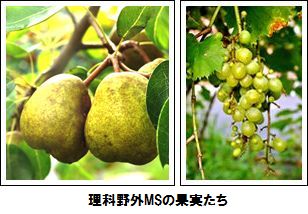
As we move from summer to autumn, the Summer Darter Dragonflies disappear and the trees around the school start to change. The Chinese Quince trees in the west of the school are bearing fruit that bring a relaxing fragrance to the area.
Speaking of bearing fruit for the next generation, what kind of secrets do plants rely on for their survival?
The Fig trees that are growing in the outdoor Science Media Space attract Brown-eared Bulbuls and Starlings that peck at the fruit. The Fragrant Orange-colored Olive trees attract flies and bees with their fragrances for them to carry away pollen. The trees use their sweetness and fragrances to trick the animals into spreading their seeds.
By the way, the fruit and vegetables that we get from the supermarket are there because we humans like them or because of economics, but it could be said that the plants are using humans to be spread to many places.
Next time you go to the supermarket, think about how the plants are carrying out their skillful strategy.
第72回 雲は風が空に描く物語
~秋の雲を眺めてみよう!~
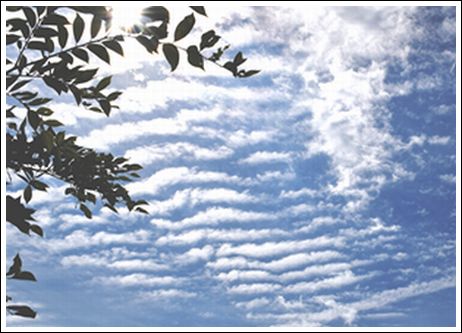
「天高く馬肥ゆる秋」という言葉があります。
最近はあまり聞かなくなりましたが、秋は大気が澄み渡り、空が高く見えるのは事実です。
そして、そこに浮かぶ雲の表情も実に豊かです。下を向いてスマホやiPad画面にばかり集中している人は、自然の織りなす物語に触れる機会を自ら失っています。
「青空を約束する白くてふわふわの晴れ雲、雨や雪を連れてくる嵐雲。畑を耕す農民たちは、雲の様子で天気を占う。…都会では雲に気づくことが少なくなった。…雲は風が空に描く物語。海を渡り、陸地を渡って進む大気の塊の航跡を示している。」 (レイチェル・カ─ソン)

いつでもどこでも上空を見上げると、そこにはその時にしか見られない表情豊かな風が描いた絵画が広がっています。しばらく佇んでいると意外に変化が早いことに気付くことでしょう。
雲には「十種雲形」という基本となる形がありますが、それは基本となるタイプ分けで、雲には全く同じ形のものなどありません。そして水と雲と風の共同作業で表現される物語は、実に科学的で創造的です。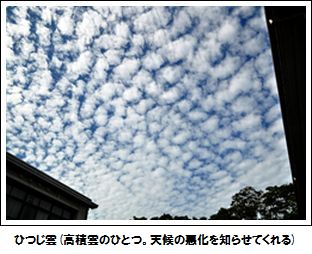 最初の写真は「波状雲」という雲で、今後天候が崩れることを知らせてくれます。魚のサバの背の模様に似ているため「鯖雲」とも言われる雲です。
最初の写真は「波状雲」という雲で、今後天候が崩れることを知らせてくれます。魚のサバの背の模様に似ているため「鯖雲」とも言われる雲です。
さて、有名な『上を向いて歩こう』という歌の歌詞の中に「幸せは雲の上に 幸せは空の上に」とあります。
コロナ禍の中、たまにはゆったりとした心で上空を仰ぎ、地球自然が織りなす自然の物語に思いを馳せてみてはいかがでしょうか。
There is a saying “Autumn comes with harvest time and clear weather. Autumn with the sky clear and blue, and horses growing stout.”. We don’t hear it much, but it’s true that the sky looks special in autumn. The clouds are abundant in the sky, so if you are only looking down at your phones and iPads, you’ll miss out on seeing them. The biologist Rachel Carson wrote about the beauty of the clouds that we can see. Anytime we look up at the sky, we can see a work of art being drawn there that only lasts for that moment, before it changes to a new design.
It is said that there are 10 different basic types of clouds, but it’s also known that no two clouds are ever the same. The combination of water, clouds, and wind work together to produce a story that is chemically creative.
The first photo is an “undulates cloud”, or “wavy cloud”, which tells us that the weather is turning bad. It looks like the bones of a mackerel, so it is also called a “mackerel cloud”.
If you know the famous Japanese song “Sukiyaki”, you will know the lyrics about there being happiness in the sky above the clouds. In these times, sometimes we should look up at the sky and see what kind of story nature is telling us through its clouds.
第71回 飛翔! アブラコウモリ
~岩倉川の哺乳類~
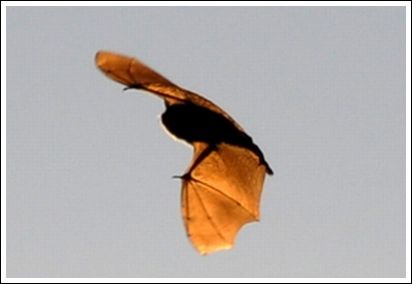 岩倉川でよくみかける動物と言えば、カワムツ、 ドンコ、ヨシノボリ(魚類)、カルガモ、セグロセキレイ、コサギ、アオサギ(鳥類)、アオダイショウ、シマヘビ(爬虫類)などですが、哺乳類で言えばコウモリです。現在、地球上の哺乳類の1/4がコウモリの仲間と言われています。
岩倉川でよくみかける動物と言えば、カワムツ、 ドンコ、ヨシノボリ(魚類)、カルガモ、セグロセキレイ、コサギ、アオサギ(鳥類)、アオダイショウ、シマヘビ(爬虫類)などですが、哺乳類で言えばコウモリです。現在、地球上の哺乳類の1/4がコウモリの仲間と言われています。
写真のコウモリは小型のアブラコウモリ(Pipistrellus abramus)。夕方になると岩倉川付近でヒラヒラと飛びまわっています。視覚より超音波で周囲のようすを探ります。
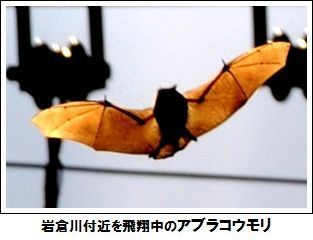 コウモリは、鳥の羽とはことなり、私たちの指と指の間に膜(飛膜)をつけたような身体をしています。翼に見えるのはいわば「手のひら」ですから、膜の中の黒い筋は指の骨なのです(親指は上に突き出ている)。
コウモリは、鳥の羽とはことなり、私たちの指と指の間に膜(飛膜)をつけたような身体をしています。翼に見えるのはいわば「手のひら」ですから、膜の中の黒い筋は指の骨なのです(親指は上に突き出ている)。
よく「コウモリは逆さで生活していて頭に血が上らないの?」と疑問にもつ人もいますが、もともと血液量が少なく、また血管にも網目状の工夫があるようです。
みなさんの家の近くの川でも、夕方ヒラヒラと”黒い飛翔物”がいたら、私たちのなかま哺乳類のコウモリかも知れません。
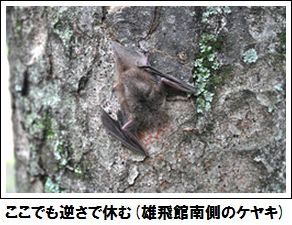 While we see many animals along the Iwakura River, such as fish, birds, and reptiles, we can also see mammals such as bats. Bats make up 1/4 of the mammals in the world.
While we see many animals along the Iwakura River, such as fish, birds, and reptiles, we can also see mammals such as bats. Bats make up 1/4 of the mammals in the world.
In the photos, you can see Japanese House Bats.
They can be seen flying around the Iwakura River in the evening, where they use ultrasonic waves instead of their sight to search their surroundings.
Unlike birds, bats have a membrane between their fingers that looks like wings, but is actually their hands, so the black lines in the membrane are bones, (with a thumb sticking out).
People often wonder if the blood doesn’t go to their heads when they hang upside down, but they don’t have much blood, and their veins are built to protect them.
If you see something black flying near a river by your house, it might be a mammal just like you.
第70回 植物はいつもステイホーム
 今、ヒトの世界で求められるステイホームですが、見渡せば植物は常にステイホームです。種子が落ちた場所で芽生えてからは、その場所で水と光、養分を得て生長していきます。米や麦を食した人類は植物が動かないので定住生活に移行したとも言えそうです。
今、ヒトの世界で求められるステイホームですが、見渡せば植物は常にステイホームです。種子が落ちた場所で芽生えてからは、その場所で水と光、養分を得て生長していきます。米や麦を食した人類は植物が動かないので定住生活に移行したとも言えそうです。
「人類はこれまで、植物の能力を不当に見過ごしてきた。今こそ人類が植物の分散型構造やレジリエンスから学び、地上に誇るその稀有な能力を自らの生存のために使う時だ。」(ステファノ・マンク━ゾ)
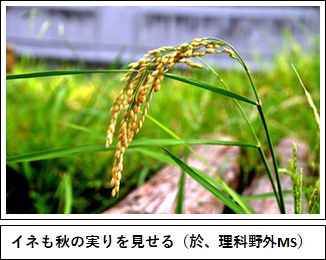 植物にはヒトの五感よりも多い「二〇感」もあると言います。しかも全身に情報処理センターを配置するモジュール構造を備え、根の根端に至っては、重力、温度、湿度、磁場、光、圧力、化学物質、重金属、音振動、酸素・二酸化炭素の有無などのデータ処理を他の根端とネットワークを築きながら判断している・・・。
植物にはヒトの五感よりも多い「二〇感」もあると言います。しかも全身に情報処理センターを配置するモジュール構造を備え、根の根端に至っては、重力、温度、湿度、磁場、光、圧力、化学物質、重金属、音振動、酸素・二酸化炭素の有無などのデータ処理を他の根端とネットワークを築きながら判断している・・・。
日頃は地下で見えない場所で繰り広げられている生命活動に、私たちは全く気付いていません。
時季が来れば種子を風で飛ばし、また動物を巧みに利用して子孫を広げ、ヒトは食べ物、空気、薬草、エネルギーとして最大限の恩恵を得ています。
私たちは植物からステイホームの極意を学ぶ必要がありそうです。
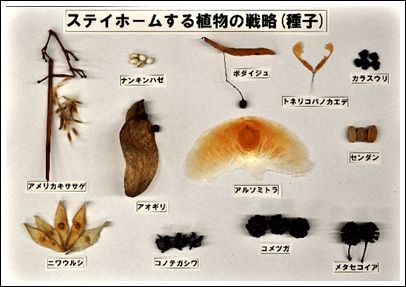 Now, people around the world are being asked to “stay home”, but we should remember that plants have always been staying home. They grow where they fall as a seed, getting the water, light and nutriments there. When people wanted to eat rice or wheat, they moved to where the plants were.
Now, people around the world are being asked to “stay home”, but we should remember that plants have always been staying home. They grow where they fall as a seed, getting the water, light and nutriments there. When people wanted to eat rice or wheat, they moved to where the plants were.
Stefano Mancuso said that people have a lot to learn from plants and it’s time to appreciate them more. While people only have 5 senses, it is thought that plants have 20.
They use these senses to process information and control the data from things they get from their surroundings, such as light, humidity, carbon dioxide, and even gravity. It’s like they have a network in their roots to make decisions. We can’t see underground, so we don’t usually realize how plants grow. When the season comes, the plants spread their seeds, feed animals, produce food, medicines, and energy for people, providing so much for us. People really should learn the secret of how to stay home from plants.
第69回 イチョウの葉を観る
~進化のサインに触れる~
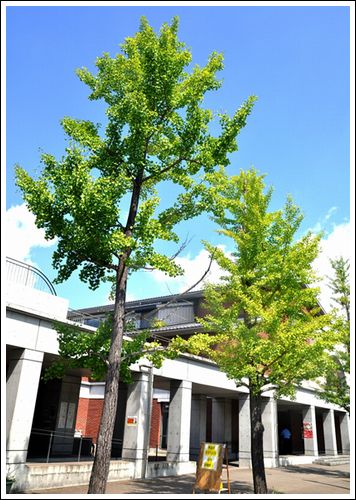 「新型コロナ」の影響で人類の世界ではさまざまな影響を受けていますが、自然界の動植物は例年と変わらない日々を送っています。
「新型コロナ」の影響で人類の世界ではさまざまな影響を受けていますが、自然界の動植物は例年と変わらない日々を送っています。
学内の各所のイチョウ並木も元気いっぱいです。こんな「コロナの時代」だからこそ、日々の生活では目にもとめない身の回りの動植物の奥深さにこそ、意識を向けてみたいものです。
そこで、今回はイチョウの葉の深みに招待します。イチョウの葉をよく見ると他の植物の葉とは違った特徴に気づきます。根元の1本から2本、2本から4本と葉脈が倍増し、末広がりになり、その結果、葉の形が扇形となります。原始的な陸上生物は初め二又分枝する茎のみからできていったと考えられています(シダ植物のマツバランも二又分岐する)。これを「テロム」と言い、その後、茎の間が組織で埋まったものが「葉」とされています(テロム説)。
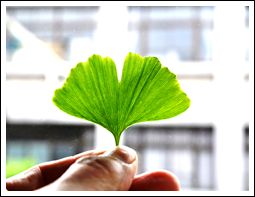 イチョウは「生きた化石」とも言われますが、約2億7千万年前の古生代の地層からその祖先の化石が発見されていて、現在見るイチョウも葉脈の中にその原始的特徴をみることができるという訳です。
イチョウは「生きた化石」とも言われますが、約2億7千万年前の古生代の地層からその祖先の化石が発見されていて、現在見るイチョウも葉脈の中にその原始的特徴をみることができるという訳です。
ステイホ-ムで、日常生活の感覚が自宅内に限定されると、意識がすべて単純化してしまいます。身近にあるものを角度を変えてみて、あえて「非日常を体験する」ことも必要な時代に生きているように思います。
みなさんも、オンライン授業で疲れた目を休め、たまには身近な「葉っぱ」に注目してみてください。
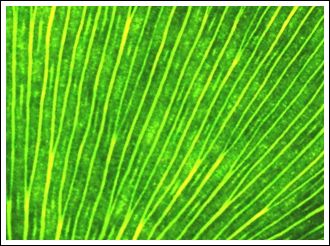 The new Corona Virus has been affecting people in many ways, but animals and plants haven’t been feeling this so much.
The new Corona Virus has been affecting people in many ways, but animals and plants haven’t been feeling this so much.
Around our school, you can see many Ginkgo trees, looking the same as always, so, even in this “Era of Corona”, we should think about the nature around us.
This time, I want to introduce to you the leaves of The Ginkgo. If you look closely, you can see how the veins of the leaf increase as you move from the root. This makes them look like a fan. The reason for this can be explained by using the Telome Theory.
Ginkgo are said to be living fossils, and examples of Ginkgo have been found in rock formations from 270 million years ago, from when they are thought to have developed into their current form.
While you were staying home, did you start to think about things in a different way? Maybe, it’s a chance to discover the “new normal”. Sometimes, you should take a rest and look at the leaves around yourself.
